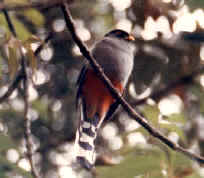 Birds
of the
Birds
of the
Dominican Republic
noting those during
Focus On Nature Tours
including birds during
FONT tours in adjacent Haiti
1994 thru 2015
during the months of January,
February,
March, April, July, December
A Dominican Republic bird list compiled by Armas Hill
PHOTO AT UPPER RIGHT: HISPANIOLAN TROGON
Cumulatively 191 species of birds have been
found
during 19 FONT birding & nature tours in the Dominican Republic since 1994.
Codes:
(t): a globally threatened or rare species or subspecies, designated by
Birdlife International
(t1): critical
(t2): endangered
(t3): vulnerable
(nt): a near-threatened species, or subspecies, globally
(He): endemic in Hispaniola
(Hi): introduced in Hispaniola
(HA): Seen in Haiti, adjacent to southwestern Dominican
Republic.
Haitian name follows HA.
Dominican Republic (Spanish) bird names follow
English names in the first line.
Scientific names in the second line.
Species found during FONT tours in the Dominican
Republic & Haiti are noted with an (*).
The numbers in ( ) indicate the number of FONT tours during which
the species has been found (out of 19).
Months during which species have been found during FONT tours are indicated.
(ph): species with a photo in the FONT website
An excellent new book entitled "Hispaniola, a Photographic Journey
through Island Biodiversity", by Eladio Fernandez, has just been published (by
Harvard University Press, in 2007).
In the book, there are some superb photographs of the nature of the Dominican
Republic. In the following list, pages in that book are referred to that have
photos of the particular species - noted with a (p.xx).
Among the outstanding bird photographs in the book are those of:
- a Stygian Owl roosting in a pine tree in the daytime,
- the first Western Chat-Tanager nest ever documented (a photo of the bird &
a photo of the eggs),
- an adult Hispaniolan Highland Tanager feeding a young bird (both birds on a
branch),
- a male Hispaniolan Crossbill (a wonderful, close photo),
- an adult Ridgeway's Hawk, with 3 young (an Hispaniolan endemic that's one of
the world's rarest birds)
Links:
Upcoming
FONT Birding & Nature Tours in the Caribbean
A Complete List & a Photo Gallery of Caribbean Birds, in 2 Parts:
Part #1: Guineafowl to
Hummingbirds Part #2: Trogons to Buntings
Rare
Birds of the Caribbean today & those that have gone extinct
Nature in the Dominican Republic including:
Mammals, Amphibians, Reptiles. Snail, Crabs, Butterflies, Dragonflies &
Damselflies

Birds:
- Helmeted (or Common)
Guinea-Fowl (Guinea) (Hi) ______
(*) (12) feb,mar,apr,jul
Numida meleagris
- Northern Bobwhite (Cordoniz)
(nt) (Hi) (ph) ______ (*) (1) mar
Colinus virginianus
- (Feral) Red Junglefowl (Gallo
(male) / Gallina (female))
(Hi) ______ (*) (4) mar,apr
Gallus gallus
- West Indian Whistling Duck (Yaguaza) (t3)
(ph) ______
(*) (4) mar,apr (has also been called West Indian Tree Duck)
Dendrocygna arborea (monotypic)
- Fulvous Whistling Duck ______
Dendrocygna bicolor
- White-faced Whistling Duck (ph) ______
Dendrocygna viduata
- Canada Goose ______
Branta canadensis
- Wood Duck (ph) ______
Aix sponsa
- American Green-winged Teal (ph) ______
Anas carolinensis
- Mallard (ph) ______
Anas platyrhynchos
- White-cheeked Pintail (Pato de la
Orilla) (ph) ______ (*) (14) feb,mar,apr,jul,dec (HA): Kanna Tet Blan
Anas b. bahamensis (t3)
- Northern Pintail (ph) ______
Anas acuta
- Blue-winged Teal (Pato de la
Florida) (ph) ______ (*) (13) feb,mar,apr,dec (HA):
Kanna Sasel
Anas discors (monotypic)
- American Wigeon (Pato Cabecilargo)
(ph) ______ (*) (7) feb,mar,apr,dec (HA):
Kanna Zel Blan
Anas americana (monotypic)
- Eurasian Wigeon (ph) ______
Anas penelope
- Northern Shoveler (Cuchareta)
(ph) ______ (*) (5) feb,apr (HA):
Kanna Souche
Anas clypeata (monotypic)
- Gadwall (ph) ______
Anas strepera
- Lesser Scaup (Pato Turco)
(ph) ______ (*) (1) mar (HA): Kanna Tet Nwa
Aythya affinis (monotypic)
- Canvasback ______
Aythya valisineria
- Redhead (ph) ______
Aythya americana
- Ring-necked Duck (ph) ______
Aythya collaris
- Hooded Merganser (ph) ______
Lophodytes cucullatus
- Red-breasted Merganser (ph) ______
Mergus serrator
- Ruddy Duck (Pato Espinoso/Pato
Rojizo) (ph) ______ (*) (4) mar,apr (HA):
Kanna Plonjon
Oxyura j. jamaicensis
- Masked Duck (Pato Criollo)
______ (*) (1) feb
Nomonyx
(formerly Oxyura) dominicus (monotypic, and the single
member of its genus)
- Black-capped Petrel (ph)
______
Pterodroma hasitata
- Great Shearwater (ph) ______
Puffinus gravis
- Manx Shearwater ______
Puffinus puffinus
- Audubon's Shearwater (ph) ______
Puffinus lherminieri
- Wilson's Storm Petrel (ph) ______
Oceanites oceanicus
- Leach's Storm Petrel ______
Oceanodroma leucorhoa
- Least Grebe (Tigua)
(ph) ______ (*) (6) feb,mar,apr,dec
Tachybaptus
(formerly Podiceps) d. dominicus
- Pied-billed Grebe (Zaramagullon)
(ph) ______ (*) (13) feb,mar,apr,dec (HA):
Plonjon Fran
Podilymbus podiceps antillarum
- American Flamingo
(Flamenco) (ph) ______ (*) (18)
feb,mar,apr,jul,dec (HA): Flamant Rose
(p. 60-61, 64, 218-219) (was considered conspecific with the Greater Flamingo of the Old
World)
Phoenicopterus ruber
- Glossy Ibis (Coco Oscuro/Coco
Prieto) (ph) ______ (*) (12) jan,feb,mar,apr,dec (HA):
Ibis Peche
Plegadis falcinellus (now said to be monotypic)
- American White Ibis (Coco Blanco)
(ph) ______ (*) (12) feb,mar,apr,jul,dec
Eudocimus albus
(monotypic)
- Roseate Spoonbill (Cuchareta)
(ph) ______ (*) (13) feb,mar,apr,jul,dec
Platalea ajaja
(monotypic)
- Wood Stork (ph) ______
Mycteria americana
- Green Heron (Cra-Cra/Cuaco)
(ph) ______ (*) (19) feb,mar,apr,jul,dec
(HA): Valet de Caiman
(p. 333)
Butorides virescens maculata
The Green Heron was for a time considered conspecific with
the nearly-cosmopolitan Striated Heron, and was then called Green-backed
Heron.
- Western Cattle Egret (Garza Ganadera)
(ph) ______ (*) (19) jan,feb,mar,apr,jul,dec
Bubulcus ibis
- Great Blue Heron (Garza Ceniza)
(ph) ______ (*) (15) jan,feb,mar,api,jul,dec (HA):
Crabier Bleu
Ardea h. herodias
- Great Egret (Garza Real)
(ph) ______ (*) (18) feb,mar,apr,jul,dec (HA):
Crabier Blanc
Casmerodius (has been Ardea) alba egretta
- Snowy Egret (Garza de Rizos)
(ph) ______
(*) (17) jan,feb,mar,apr,jul,dec (HA)
: Zegret Blan (p. 358-359)
Egretta
(formerly Leucophoyx) thula brewsteri
- Little Blue Heron (Garza Azul)
(ph) ______ (*) (16) jan,feb,mar,apr,jul,dec (HA):
Metis Krabye Ble
Egretta
(formerly Florida) caerulea (monotypic)
- Tricolored Heron (Garza Pechiblanco)
(ph) ______ (*) (17) jan,feb,mar,apr,jul,dec (HA): Crabier Aux Trois Couleurs
Egretta
(formerly
Hydranassa)
tricolor ruficollis
The Tricolored Heron was called Louisiana Heron.
- Reddish Egret (Garza Rojiza)
(ph) ______
(*) (16) feb,mar,apr,jul,dec (HA):
Zegret Ble (p. 88)
Egretta
(formerly Dichromanassa) r. rufescens
- Black-crowned Night Heron (Rey Congo)
(ph) ______ (*) (8) feb,mar,apr,jul
Nycticorax nycticorax hoactii
- Yellow-crowned Night Heron (Rey Congo)
(ph) ______ (*) (9) apr,jul,dec
Nyctanassa violacea bancrofti
(the single
member of its genus)
- Least Bittern (Martinetito)
(ph) ______ (*) (8) mar,apr
Ixobrychus e. exilis
- American Bittern (ph) ______
Botaurus lentiginosus
- White-tailed Tropicbird (Rabijunco)
(ph) ______ (*) (2) mar,apr
Phaethon lepturus catesbyi
- Red-billed Tropicbird (ph) ______
Phaethon aethereus
- Magnificent Frigatebird (Tijereta)
(ph) ______ (*) (18) jan,feb,mar,apl,jul,dec
Fregata magnificens (now said to be monotypic)
- Brown Pelican (Alcatraz/Pelicano)
(ph) ______ (*) (18) feb,mar,apr,jul,dec (p. 86-87)
Pelecanus o. occidentalis
- Brown Booby (Bubi)
(ph) ______
(*) (3) mar,apr
Sula l. leucogaster
- Red-footed Booby (ph) ______
Sula sula
- Masked Booby ______
Sula dactylatra
- Double-crested Cormorant (ph) ______
Phalacrocorax auritus
- Anhinga (ph) ______
Anhinga anhinga
- Turkey Vulture (Aura Tinosa)
(ph) ______ (*) (8) feb,mar,apr
Cathartes a. aura
- Peregrine Falcon (Halcon de Patos)
(ph) ______ (*) (4) feb,mar,apr
Falco peregrinus anatum (from North America)
Falco peregrinus tundrius (from North America, north of F. p.
anatum)
- Merlin (Halconito)
(ph) ______ (*) (11) feb,mar,apr,dec
Falco c. columbarius
- American Kestrel (Cuyaya/Cernicalo)
(ph) ______ (*) (19) jan,feb,mar,apr,jul,dec (p. 355)
Falco sparverius dominicensis (subspecies endemic to Hispaniola)
- Osprey (Guincho)
(ph) ______
(*) (14) jan,feb,mar,apr,dec (HA):
Malfini Lanme
Pandion haliaetus carolinensis (migrant North American breeder)
Pandion haliaetus ridgwayi (breeder in Caribbean area)
- Northern Harrier (ph) ______
Circus hudsonius
- Sharp-shinned Hawk (Guaraguaito de Sierra)
(ph) ______ (*) (8) feb,mar,apr,jul
Accipiter s. striatus (t3) (this subspecies, the
nominate, endemic to
Hispaniola)
- Red-tailed Hawk (Guaraguao)
(ph) ______ (*) (18) feb,mar,apr,jul,dec
Buteo j. jamaicensis (the same subspecies as also
in Jamaica & Puerto Rico)
- Ridgway's (or Hispaniolan)
Hawk (Guaraguaito)
(t1) ______ (*) (4) mar,apr (p. 302-303)
Buteo ridgwayi (monotypic)
- Black Rail (nt) ______
Laterallus jamaicensis
- "Antillean" Clapper Rail (Gallinuela de Mangle)
(ph) ______ (*) (3) apr,jul
Rallus crepitans caribaeus
- Sora (Gallito)
______ (*) (1)
Porzana carolina (monotypic)
- Yellow-breasted Crake (Gallito Amarillo)
______ (*) (1) apr
Porzana flaviventer hendersoni
(this subspecies on Hispaniola &
Puerto Rico)
- Spotted Rail (Gallito Manchado)
______ (*) (1) apr
Pardirallus maculatus inoptatus
- Purple
Gallinule (Gallareta Azul)
(ph) ______ (*) (7) mar.apr,dec
Porphyrio martinicus
(monotypic)
- Common Gallinule (Gallareta
Pico Rojo) (ph) ______ (*) (15) jan,feb,mar,apr,jul,dec
(HA): Poul Dlo Tet Rouj
Gallinula chloropus cerceris
- American Coot (Gallareta Pico Blanco)
(ph) ______ (*) (5) feb,apr (HA): Poul Dio Jidel
Fulica a. americana
- Caribbean Coot
(Gallareta
Pico Blanco) (nt) ______ (*) (13) feb,mar,apr,dec (HA): Poul Dlo Tet Blan
Fulica (americana) caribaea
The Caribbean Coot has been considered by some to be
conspecific with the American Coot.
- Limpkin (Carrao)
(ph) ______ (*) (9) mar.apr
Aramus guarauna elucus (t3) (this subspecies now endemic to Hispaniola, as
it has been extirpated in Puerto Rico) (the single member of its
family)
- Double-striped Thick-knee (ph) ______
Burhinus bistriatus dominicensis (subspecies endemic to Hispaniola)


 Birds
of the
Birds
of the ![]()